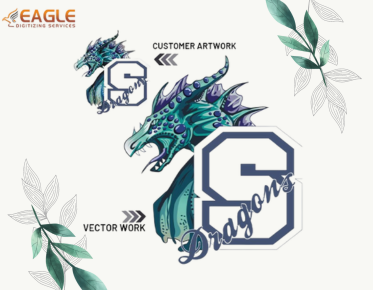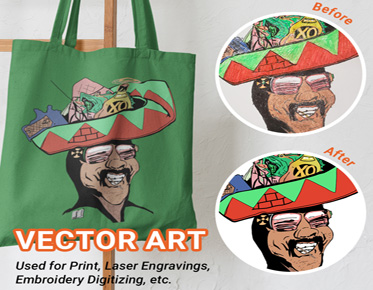PCB Manufacturing 101: Essential Silkscreen Materials You Need/Eagle Digitizing
Printed Circuit Boards (PCBs) are at the heart of nearly every electronic device today. They provide the necessary support and connectivity for various electronic components, allowing them to function seamlessly. The process of manufacturing these boards is intricate and requires a variety of materials, each playing a critical role in the final product's functionality and durability. For the top-notch online vector artwork conversion, don't hesitate to get in touch with us.
One often overlooked, but crucial, element of PCB manufacturing is the silkscreen layer. This layer involves printing important information and labels onto the surface of the PCB, including component identifiers, test points, logos, and other necessary details. In this article, we will explore PCB manufacturing, with a particular focus on the materials used in silkscreen printing, and why they are essential to the overall success of the board.
Introduction to PCB Manufacturing
PCB manufacturing involves the creation of a board that connects and supports various electronic components, such as resistors, capacitors, and microprocessors. The PCB serves as a mechanical foundation and provides the electrical pathways needed for components to communicate effectively.
The manufacturing process includes several critical steps, including etching, drilling, plating, solder mask application, and silkscreen printing. Each stage is carefully controlled to ensure that the board functions properly and meets design specifications.
PCBs can be classified into different types based on their design and intended use, such as single-layer, double-layer, and multilayer boards, as well as rigid, flexible, and rigid-flex PCBs.
Types of PCBs
There are several kinds of PCBs, categorized based on their construction, functionality, and applications:
● Single-Layer PCBs: These PCBs have one layer of conductive material and are used in simple, low-cost devices.
● Double-Layer PCBs: These boards have two layers of conductive material, offering more space for components and traces.
● Multilayer PCBs: These consist of three or more conductive layers, used in complex devices such as computers and smartphones.
● Rigid PCBs: These PCBs are made with solid, inflexible materials and are common in applications where durability is essential.
● Flexible PCBs: These are made from flexible materials like polyimide, allowing the board to bend or twist.
● Rigid-Flex PCBs: A combination of rigid and flexible PCB materials, offering flexibility and strength for more complex designs.
PCB Manufacturing Process
The process of PCB manufacturing is highly technical and involves a series of precise steps. Below is a breakdown of the typical stages of PCB production:
Design and Schematic Creation
The process starts with a schematic, or blueprint, of the PCB layout, often created using specialized software such as Eagle or Altium Designer. This layout includes the placement of components, copper traces, and vias (connections between layers).
Photomasking and Imaging
Once the design is finalized, the image of the PCB is transferred onto the copper-clad substrate using a photo masking process. A thin layer of photoresist is applied, which hardens when exposed to UV light. The unhardened portions are removed, leaving behind a precise pattern of traces.
Etching
In the etching stage, the exposed copper is removed using chemical solutions, leaving only the copper traces that were covered by the photoresist. Ferric chloride is a common etchant used in this process.
Drilling
After etching, holes for vias, component leads, and mounting are drilled. These holes, often referred to as through-holes, are essential for connecting different layers and mounting components on the PCB.
Plating
In the plating process, the drilled holes are plated with copper to create electrical connections between different layers of the PCB. This is followed by additional plating to strengthen the connections.
Solder Mask Application
Once the copper traces are formed and the holes drilled and plated, the solder mask is applied to the board. This insulating layer protects the traces from corrosion and oxidation.
Silkscreen Printing
Next, a silkscreen layer is printed onto the board. This layer adds component identifiers, labels, and other important information to guide assembly and testing.
Surface Finishing
Surface finish is applied to ensure that the exposed copper pads remain solderable and resistant to corrosion. The choice of surface finish depends on factors like budget, performance requirements, and the type of assembly (e.g., manual or automated).
Electrical Testing
The final step in PCB manufacturing is electrical testing, where the board is tested for continuity, short circuits, and adherence to design specifications. Automated testing equipment (ATE) is typically used to verify that all connections are functioning as intended.
Silkscreen in PCB Manufacturing
The silkscreen layer on a PCB serves a key purpose: it adds valuable information to the board's surface. This information typically includes:
● Component Labels: Identifying various components and their placements on the PCB.
● Test Points: Indicating where testing can be done to ensure functionality.
● Logos: Adding branding or certification marks.
● Polarity Indicators: Helping engineers correctly place polar components like diodes and capacitors.
Silkscreen printing is applied over the solder mask and is typically done in white, though other colors like black or yellow may be used depending on the specific needs of the board design. Without the silkscreen, assembling and testing a PCB would be more complex and prone to error.
Silkscreen Materials for PCB Manufacturing
Silkscreen materials are crucial in PCB manufacturing as they ensure that the text, symbols, and labels are durable, legible, and able to withstand the manufacturing process. Several types of materials are used, each offering unique properties:
Epoxy-Based Inks
Epoxy-based inks are one of the most commonly used materials for silkscreen printing in PCB manufacturing. These inks offer excellent adhesion to the PCB surface and are highly resistant to wear and chemical exposure. Epoxy inks are also durable, making them ideal for boards that will undergo harsh environments.
Advantages:
● Good adhesion to most PCB substrates.
● High chemical and heat resistance.
● Cost-effective.
Disadvantages:
● Longer curing time compared to UV-cured inks.
● Limited color options.
UV-Curable Inks
UV-curable inks are another popular choice due to their fast curing times. These inks are hardened using ultraviolet light, which significantly speeds up the production process. UV-curable inks are available in a wide variety of colors and can produce very fine details, making them perfect for more complex PCBs.
Advantages:
● Fast curing process.
● High-resolution printing.
● Available in multiple colors.
Disadvantages:
● Requires specialized equipment (UV light for curing).
● May be less durable than epoxy inks in some extreme conditions.
Liquid Photoimageable (LPI) Solder Masks
Though primarily used as solder masks, LPI materials can also be used for silkscreen printing in certain applications. LPI provides excellent resolution and can be applied very thinly, making it a good option for high-density PCB designs.
Advantages:
● Excellent resolution for fine details.
● Thin application ensures minimal impact on PCB functionality.
● Offers good chemical resistance.
Disadvantages:
● Requires photomasking equipment.
● More expensive than epoxy and UV-cured inks.
Water-Based Inks
Water-based inks are environmentally friendly and non-toxic, making them a great choice for manufacturers looking to reduce their environmental impact. These inks are less common in PCB manufacturing but can be used in applications where durability and chemical resistance are not major concerns.
Advantages:
● Environmentally friendly.
● Easy to clean up.
● Non-toxic.
Disadvantages:
● Not as durable as epoxy or UV-cured inks.
● Limited resistance to chemicals and heat.
Thermoset Inks
Thermoset ink is a type of ink that requires heat to cure, creating a durable and heat-resistant layer. These inks are highly resistant to wear, chemicals, and heat, making them suitable for industrial applications where the PCB will be exposed to harsh environments.
Advantages:
● Highly durable.
● Excellent resistance to heat and chemicals.
● Suitable for industrial applications.
Disadvantages:
● Requires heat curing, adding to the processing time.
● Limited color options.
Silkscreen Printing Methods
Several methods are available for applying the silkscreen layer onto a PCB. The choice of method depends on the complexity of the design, the production volume, and the type of materials being used.
Manual Screen Printing
This traditional method involves using a stencil or mesh screen to transfer ink onto the PCB. A squeegee is used to press ink through the screen, allowing it to adhere to the surface of the PCB. Manual screen printing is typically used for low-volume production runs or prototyping.
Liquid Photo Imaging (LPI)
In Liquid Photo Imaging, a light-sensitive material is applied to the PCB. The design is transferred onto the board using ultraviolet light, and the unexposed areas are removed, leaving behind the silkscreen pattern. This method is used for high-resolution designs and is commonly applied in high-volume manufacturing.
Direct Legend Printing (DLP)
Direct Legend Printing is an advanced method that uses inkjet technology to print the silkscreen directly onto the PCB. This method offers excellent resolution and can apply multiple colors with great precision. It’s particularly useful for complex, high-density boards where fine details are required.
Choosing the Right Silkscreen Materials
Selecting the right silkscreen materials depends on several factors, including:
● Board complexity: High-density designs may require UV-curable or LPI inks for fine detail.
● Environmental conditions: Boards exposed to harsh environments will benefit from durable materials like epoxy or thermoset inks.
● Production volume: High-volume manufacturing may require faster curing inks like UV-curable options.
● Color and resolution needs: Epoxy and UV-curable inks offer multiple color options, while LPI and DLP methods allow for high-resolution printing.
Importance of Silkscreen Quality and Accuracy
The quality and accuracy of the silkscreen are essential for ensuring proper assembly, testing, and troubleshooting. Poor silkscreen printing can lead to misidentification of components, increased error rates in assembly, and challenges during testing and repair. Ensuring that the silkscreen layer is clear, durable, and accurately printed is a critical step in the PCB manufacturing process. For the excellent online vector art services, have no qualms about getting in touch with us.
Common Challenges in Silkscreen Printing
Several challenges can arise during the silkscreen printing process, including:
● Blurring or smudging: Caused by improper alignment or too much pressure during printing.
● Incomplete coverage: Due to improper stencil alignment or insufficient ink application.
● Ink peeling: This can occur if the ink is not cured properly or if the material used is not suitable for the environmental conditions the PCB will face.
● Legibility issues: Caused by the use of inappropriate materials or poor printing resolution.
Silkscreen printing in PCB manufacturing is a critical step in the overall process, ensuring that necessary information is clearly visible for assembly, testing, and troubleshooting. The choice of silkscreen materials, including epoxy-based inks, UV-curable inks, and thermoset inks, will depend on the specific requirements of the board, such as its intended environment, complexity, and durability.
The right selection of materials and printing techniques will significantly impact the quality and reliability of the final product. As technology continues to advance, the need for precision and accuracy in silkscreen printing will only grow, making it more important than ever to understand the materials and methods involved in this essential aspect of PCB manufacturing.



.png)